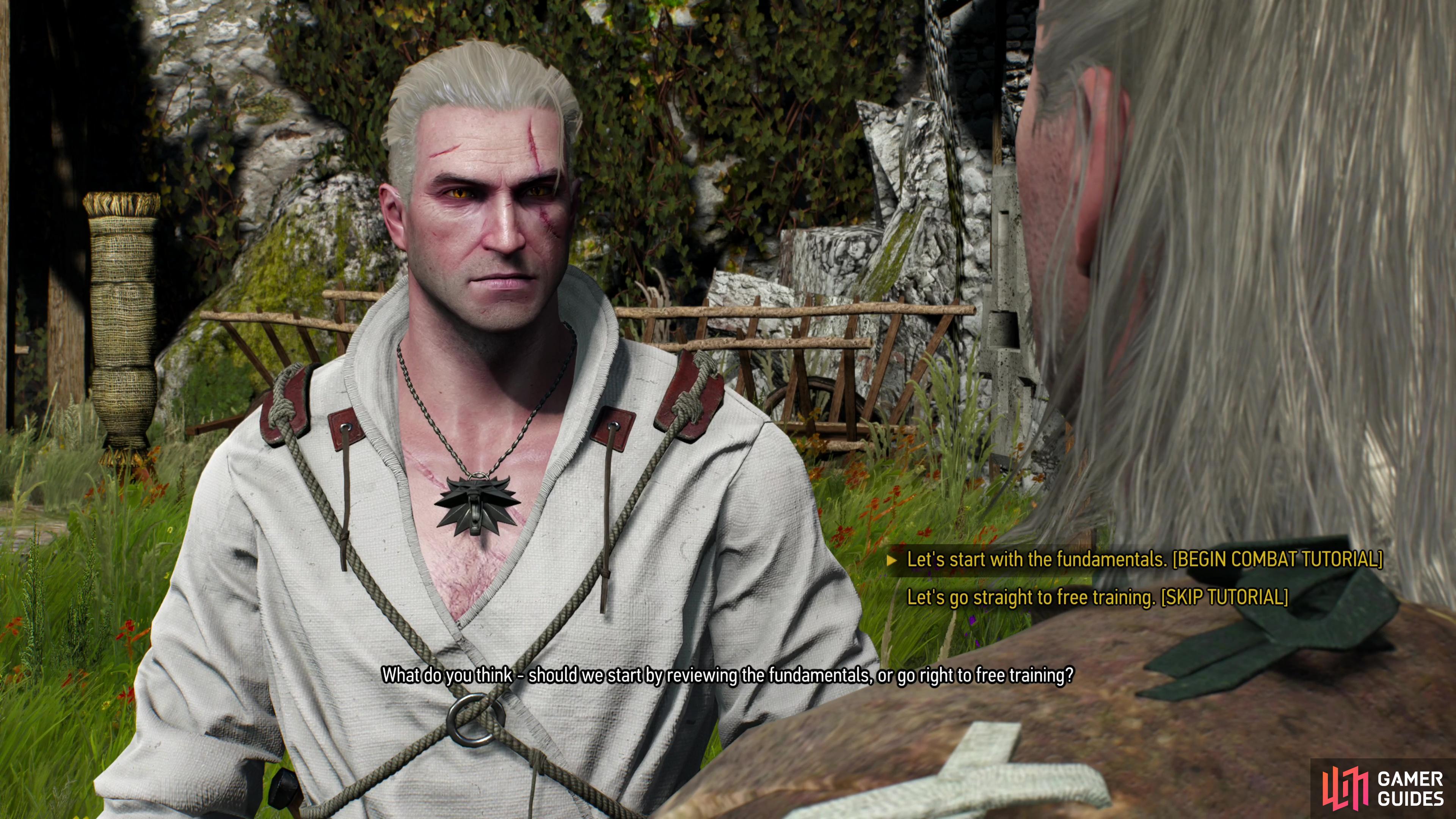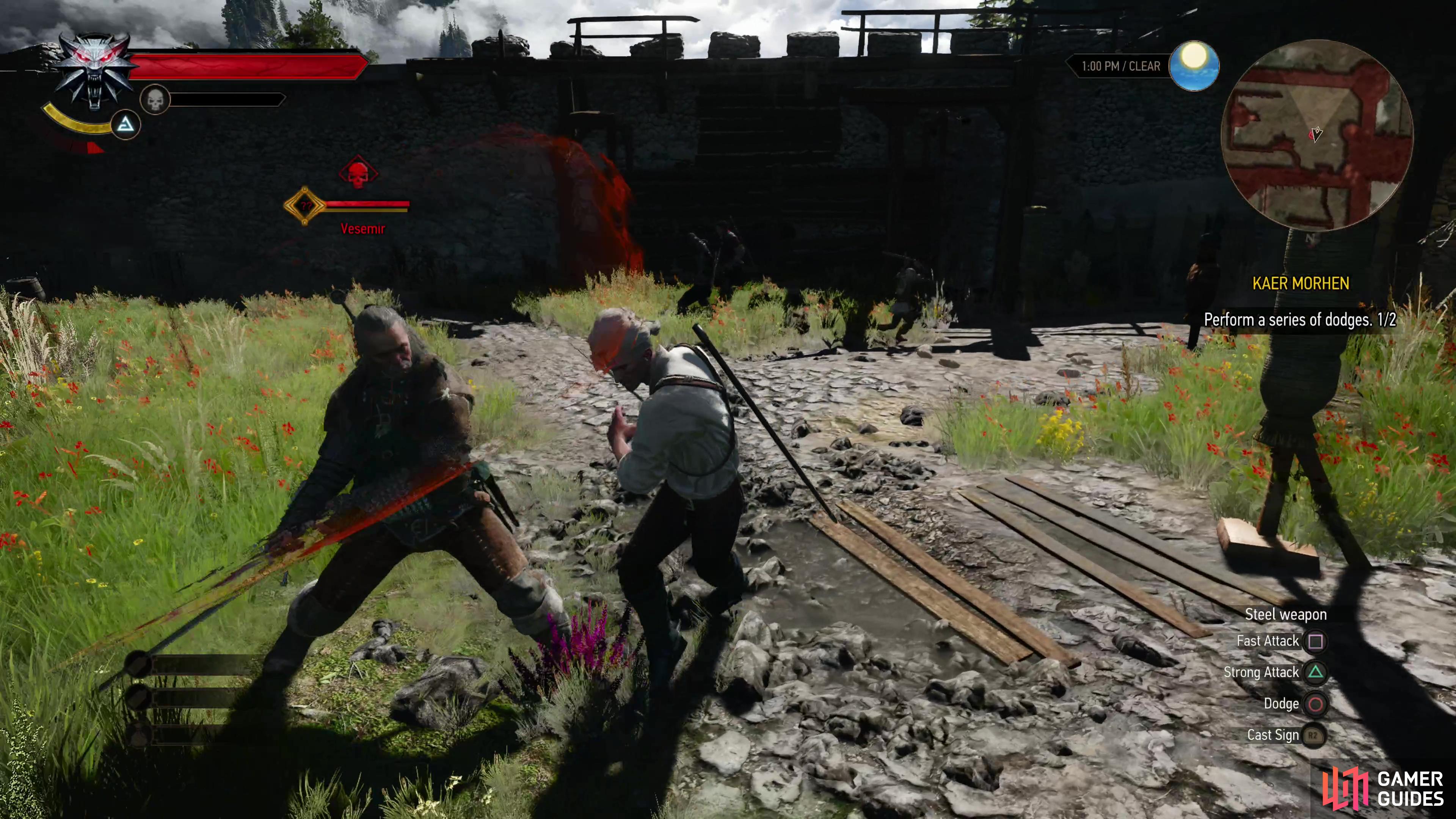After you’re done choosing your game settings you’ll be treated to a cinematic before the game properly starts in a possibly familiar tower in Kaer Morhen - home of the School of the Wolf. Geralt’s cozy bath will be interrupted by some magical crustacean mischief on the part of his lover, Yennefer, and after being reprimanded Geralt will be tasked with fulfilling his promise to Ciri. Use the quick jump table below to go straight to the parts you need or keep reading for a complete walkthrough.
Objectives¶
| Objectives |
|---|
| Find the Key and Talk to Ciri |
| Running the Walls - Movement Tutorial |
| Combat Tutorial |
| Attacking, Dodging, Rolling and Parrying |
| Signs Tutorial |
| Bombs Tutorial |
(1 of 2) You can find the key you need on a book along the northern end of the room.
You can find the key you need on a book along the northern end of the room. (left), Use your witcher senses to highlight interactable objects red and yellow. (right)
Find the Key and Talk to Ciri¶
Your first task is to procure a key for the door, which has been wisely locked to keep prying eyes out. Aside from pointlessly extinguishing candles, examining various objects and getting some commentary from Geralt and Yennefer, there’s not much else to do here. You’ll find this key along the northern end of the room, on a book on a table near the door. This is an opportunity to try out your Witcher senses, which you can activate by holding 

Unlock the door and strut downstairs, Geralt-style. Once on the ground floor Geralt will note that the elder Witcher of the Kaer Morhen school, Vesemir, has failed at keeping an eye on Ciri. Instead of some dull book-work, Ciri decided to terrorize some training dummies while Vesemir caught forty winks. After some chatter with Vesemir (your dialogue responses largely don’t matter here, save for skipping some tutorials), Geralt heads down to chastise the young aspiring Witcher. After chatting with Ciri for a bit, she’ll ask if you want to “run the walls”, which is a handy, more in-depth tutorial covering basic mobility - climbing, running, etc.
(1 of 2) Meet up with Ciri and you’ll be prompted to “run the walls”,
Meet up with Ciri and you’ll be prompted to “run the walls”, (left), starting a race where you’ll learn how to run, climb, vault and generally move around as Geralt. (right)
Running the Walls - Movement Tutorial¶
If you choose to “run the walls”, start out by heading west and climbing a ladder, then scale two platforms to the north 

(1 of 3) After running the walls you’ll be offered a combat tutorial, courtesy of Vesemir.
Combat Tutorial¶
Choose to “start with the fundamentals” and Geralt will claim a sword for him to use. The game will briefly introduce you to the three basic tools of a Witcher-swords, signs, and alchemy. For now, we’re focusing on swords. Press 



Attacking, Dodging, Rolling and Parrying¶
Once your sword is out, lock onto Vesemir by pressing down on the 












(1 of 3) Vesemir will also kindly walk you through the various signs you have at your disposal,
Signs Tutorial¶
Now it’s time to move onto Signs. Hold 



-
Quen: Creates a defensive barrier on Geralt. Lasts until hit or until the duration expires. Should nullify most attacks entirely, but some heavy attacks are strong enough to damage Geralt through the shield and possibly knock him prone. With the “Active Shield” upgrade you can hold
to absorb attacks - this will drain your stamina proportionally to the damage absorbed, but with upgrades can also restore your Vitality!
-
Igni: Shoots a cone of flame at enemies, dealing damage and possibly setting them on fire for damage-over-time. Best purely offensive spell Geralt has, although it’s very weak until you boost sign intensity. Later in the game it’s great against high HP enemies like Bears and Cyclops because the spell’s DoT (Damage over Time) is proportional to the target’s HP.
-
Aard: Projects a wave of force at enemies, potentially staggering them, knocking them prone, or even sending them flying off ledges! Effects vary depending on sign intensity, the enemy’s mass and the terrain. In theory staggering evasive enemies or knocking foes off cliffs sounds great, in reality, you’re often better off using other signs.
-
Axii: Attempts to beguile a foe, causing it to lower its guard or even charming it into fighting on your behalf! Can be useful during dialogue, in combat it’s also very situational - must-have versus Alghouls, but otherwise of limited utility.
-
Yrden: Create a ring of magical runes that debuff enemies who enter, usually by slowing them. If you unlock the sign’s alternative sign mode “Magic Trap” it’ll create… a magic trap that damages enemies and destroys projectiles passing through the area. It’s most useful against incorporeal enemies like wraiths, as it forces them to become corporeal and hence much more receptive to sword damage.
Bombs Tutorial¶
Swords and signs are done, which leaves only alchemy, which in this case means bombs. Press 







You can now freely train with Vesemir, and it’s nice to have the gloves off. Practice dodging, countering, attacking… all that good stuff… but especially dodging, countering and keeping Quen up. Those skills will come in very handy, especially on Death March! difficulty. The training ends when you sheath your sword 












 Sign up
Sign up
No Comments